Bird R.B., Stewart W.E., Lightfoot E.N. Transport Phenomena
Подождите немного. Документ загружается.

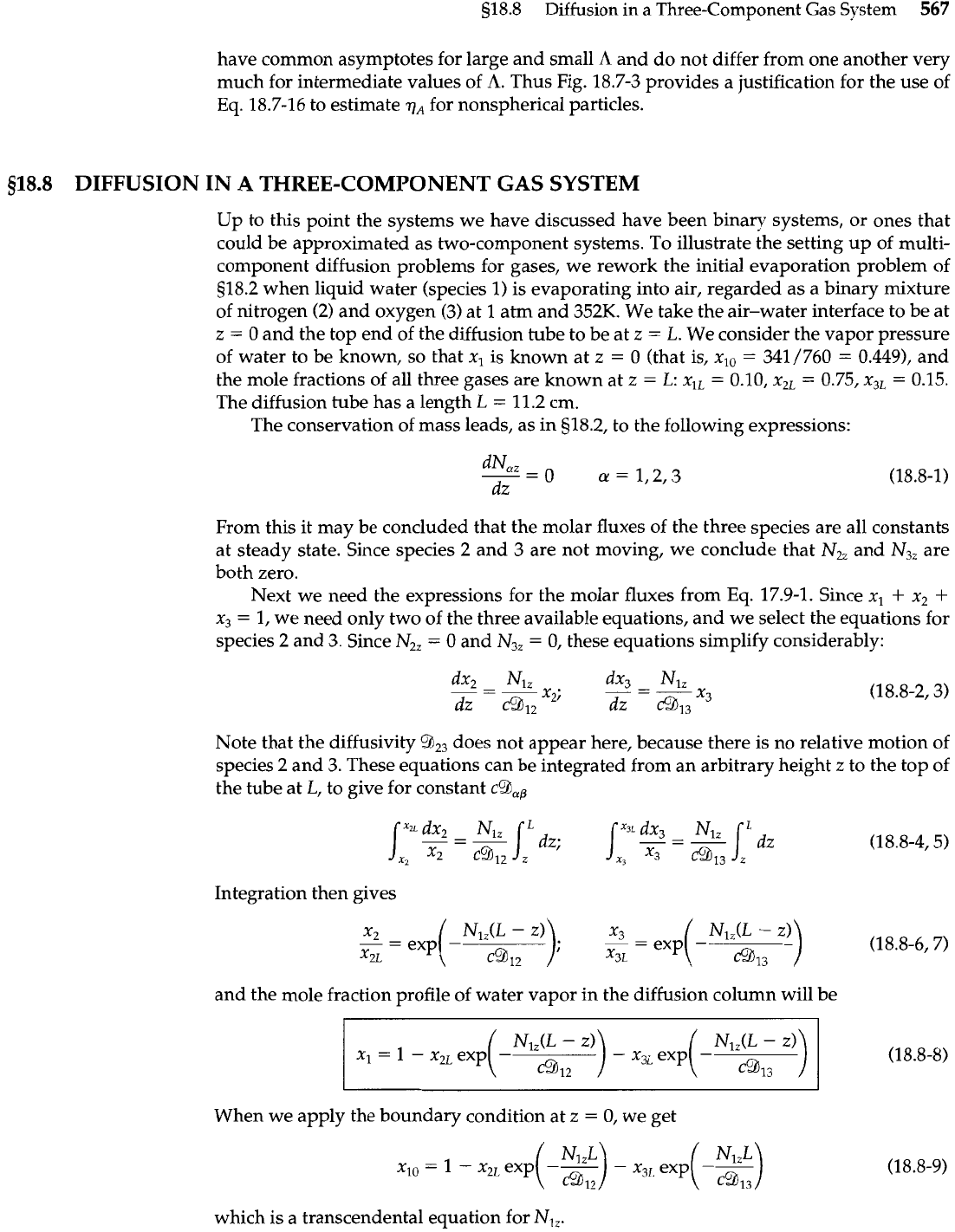
$18.8 Diffusion in a Three-Component Gas System
567
have common asymptotes for large and small
A
and do not differ from one another very
much for intermediate values of
A.
Thus Fig. 18.7-3 provides a justification for the use of
Eq. 18.7-16 to estimate
r],
for nonspherical particles.
$18.8
DIFFUSION IN A THREE-COMPONENT GAS SYSTEM
Up to this point the systems we have discussed have been binary systems, or ones that
could be approximated as two-component systems. To illustrate the setting up of multi-
component diffusion problems for gases, we rework the initial evaporation problem of
518.2 when liquid water (species 1) is evaporating into air, regarded as a binary mixture
of nitrogen (2) and oxygen
(3)
at 1 atrn and 352K. We take the air-water interface to be at
z
=
0
and the top end of the diffusion tube to be at
z
=
L.
We consider the vapor pressure
of water to be known, so that
x,
is known at
z
=
0 (that is,
x,,
=
341/760
=
0.449), and
the mole fractions of all three gases are known at
z
=
L:
x,,
=
0.10,
x,,
=
0.75,
x,,
=
0.15.
The diffusion tube has a length
L
=
11.2 cm.
The conservation of mass leads, as in 518.2, to the following expressions:
From this it may be concluded that the molar fluxes of the three species are all constants
at steady state. Since species 2 and 3 are not moving, we conclude that
N2,
and
N3,
are
both zero.
Next we need the expressions for the molar fluxes from
Eq.
17.9-1. Since
x,
+
x2
+
x,
=
1, we need only two of the three available equations, and we select the equations for
species
2
and
3.
Since
N2,
=
0 and
N,,
=
0,
these equations simplify considerably:
Note that the diffusivity
Enz3
does not appear here, because there is no relative motion of
species 2 and 3. These equations can be integrated from an arbitrary height
z
to the top of
the tube at
L,
to give for constant
~9,~
Integration then gives
and the mole fraction profile of water vapor in the diffusion column will be
I
I
When we apply the boundary condition at
z
=
0, we get
which is a transcendental equation for
N,,.
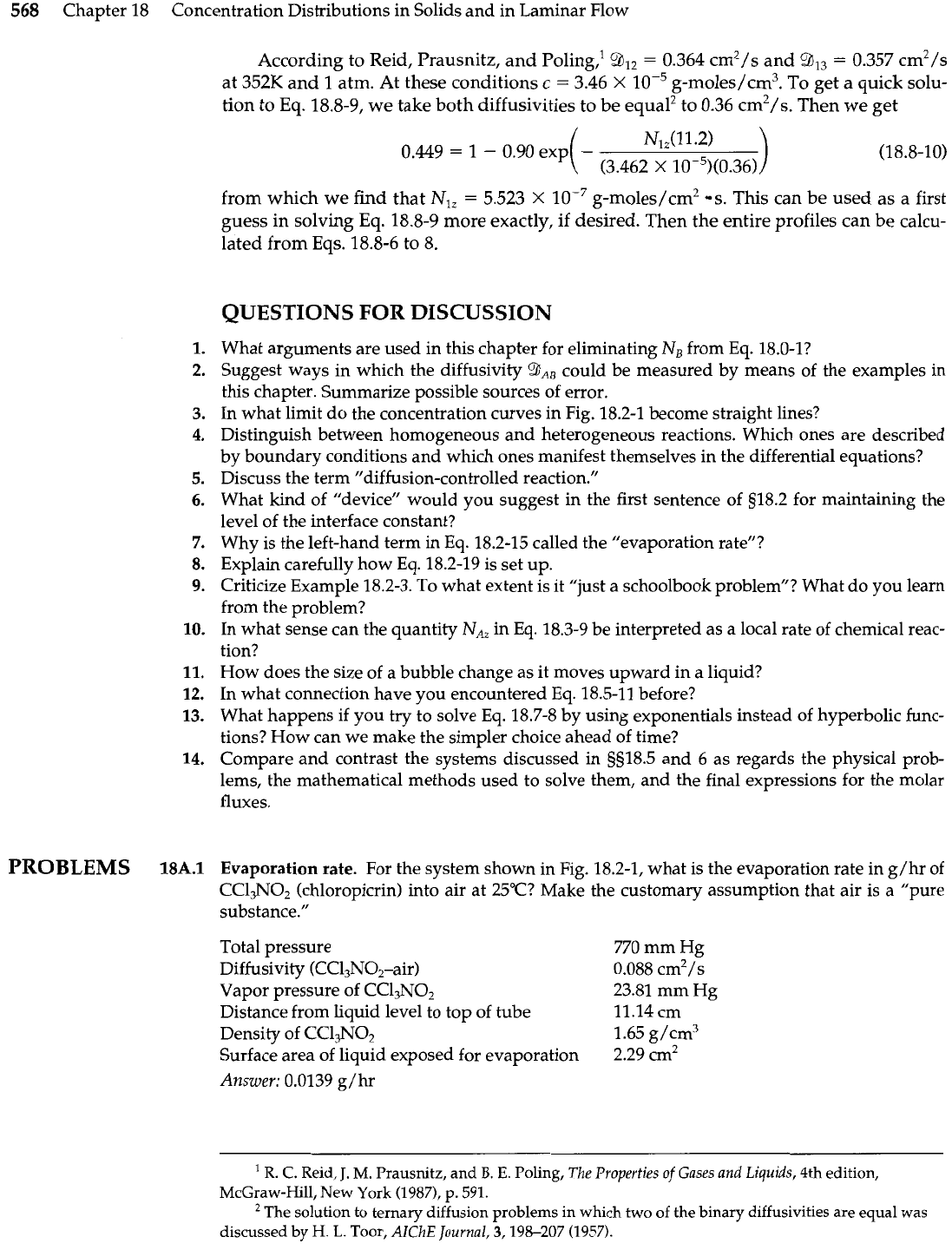
568
Chapter 18
Concentration Distributions in Solids and in Laminar Flow
According to Reid, Prausnitz, and poling,'
9,,
=
0.364 cm2/s and Q13
=
0.357 cm2/s
at 352K and
1
atm. At these conditions
c
=
3.46
X
lov5
g-moles/cm3.
To
get a quick solu-
tion to Eq. 18.8-9, we take both diffusivities to be equal2 to 0.36 cm2/s. Then we get
0.449
=
1
-
0.90 exp
-
Nlz(l 1.2)
(
(3.462
X
10-~)(0.36)
from which we find that N,,
=
5.523
X
g-moles/cm2 s. This can be used as a first
guess in solving Eq. 18.8-9 more exactly, if desired. Then the entire profiles can be calcu-
lated from Eqs. 18.8-6 to 8.
QUESTIONS FOR DISCUSSION
1.
What arguments are used in this chapter for eliminating
NB
from Eq. 18.0-l?
2.
Suggest ways in which the diffusivity
gAB
could be measured by means of the examples in
this chapter. Summarize possible sources of error.
3.
In what limit do the concentration curves in Fig. 18.2-1 become straight lines?
4.
Distinguish between homogeneous and heterogeneous reactions. Which ones are described
by boundary conditions and which ones manifest themselves in the differential equations?
5.
Discuss the term "diffusion-controlled reaction."
6.
What kind of "device" would you suggest in the first sentence of 518.2 for maintaining the
level of the interface constant?
7.
Why is the left-hand term in Eq. 18.2-15 called the "evaporation rate"?
8.
Explain carefully how Eq. 18.2-19 is set up.
9.
Criticize Example 18.2-3. To what extent is it ''just a schoolbook problem"? What do you learn
from the problem?
10.
In what sense can the quantity
NAz
in Eq. 18.3-9 be interpreted as a local rate of chemical reac-
tion?
11.
How does the size of a bubble change as it moves upward in a liquid?
12.
In what connection have you encountered Eq. 18.5-11 before?
13.
What happens if you try to solve Eq. 18.7-8 by using exponentials instead of hyperbolic func-
tions? How can we make the simpler choice ahead of time?
14.
Compare and contrast the systems discussed in §§18.5 and
6
as regards the physical prob-
lems, the mathematical methods used to solve them, and the final expressions for the molar
fluxes.
PROBLEMS
18A.1
Evaporation rate.
For the system shown in Fig. 18.2-1, what is the evaporation rate in g/hr of
CC1,N02 (chloropicrin) into air at 25OC? Make the customary assumption that air is a "pure
substance."
Total pressure 770 mm Hg
Diffusivity (CC13N02-air) 0.088 cm2/s
Vapor pressure of CC1,N02
23.81 mm Hg
Distance from Liquid level to top of tube 11.14 cm
Density of CC1,N02 1.65 g/cm3
Surface area of liquid exposed for evaporation
2.29 cm2
Answer:
0.0139 g/hr
R.
C.
Reid,
J.
M. Prausnitz, and
B.
E.
Poling,
The
Properties of
Gases and
Liquids,
4th edition,
McGraw-Hill, New York (1987), p. 591.
The solution to ternary diffusion problems in which two of the binary diffusivities are equal was
discussed by
H.
L.
Toor,
AlChE
Journal,
3,198-207 (1957).

Problems
569
+R
=
1.4cm
Fig.
18A.4.
Schematic drawing of a wetted-wall
-
Water film runs
column.
down the wall
*
Film thickness
6
-
Surface concentration
assumed equal to the
saturation concentration
Sublimation of small iodine spheres in still air.
A
sphere of iodine, 1 cm in diameter, is
placed in still air at 40°C and 747 mm Hg pressure. At this temperature the vapor pressure of
iodine is about 1.03 mm Hg. We want to determine the diffusivity of the iodine-air system by
measuring the sublimation rate. To help determine reasonable experimental conditions,
(a) Estimate the diffusivity for the iodine-air system at the temperature and pressure given
above, using the intermolecular force parameters in Table E.1.
(b) Estimate the rate of sublimation, basing your calculations on Eq. 18.2-27.
(Hint:
Assume r,
to be very large.)
This method has been used for measuring the diffusivity, but it is open to question be-
cause of the possible importance of free convection.
Answer: (a)
9dIldir
=
0.0888 cm2/s; (b)
W12
=
1.06
X
lo-*
g-mole/hr
Estimating the error in calculating the absorption rate. What is the maximum possible error
in computing the absorption rate from Eq. 18.5-18, if the solubility of
A
in
B
is known within
+5%
and the diffusivity of A in
B
is known within ?15%? Assume that the geometric quanti-
ties and the velocity are known very accurately.
Chlorine absorption in a falling film (Fig. 18A.4). Chlorine is being absorbed from a gas in a
small experimental wetted-wall tower as shown in the figure. The absorbing fluid is water,
which is moving with an average velocity of 17.7 cm/s. What is the absorption rate in g-
moles/hr, if the liquid-phase diffusivity of the chlorine-water system is 1.26
X
lop5
cm2/s,
and if the saturation concentration of chlorine in water is 0.823 g chlorine per 100 g water
(these are the experimental values at 16OC). The dimensions of the column are given in the fig-
ure. (Hint: Ignore the chemical reaction between chlorine and water.)
Answer: 0.273 g-moles/hr
Measurement of diffusivity by the point-source method (Fig. 18C.1).' We wish to design a
flow system to utilize the results of Problem 18C.1 for the measure of
B,,.
The approaching
'
This is the most precise method yet developed for measurements of diffusivity at high
temperatures. For
a
detailed description of the method, see
R.
E. Walker and
A.
A.
Westenberg,
1.
Chem.
Phys.,
29,1139-1146,1147-1153 (1958). For a summary of measured values and comparisons with the
Chapman-Enskog theory, see
R.
M.
Fristrom and
A. A.
Westenberg,
Flame Structure,
McGraw-Hill, New
York (1965), Chapter
XIII.

570
Chapter 18 Concentration Distributions in Solids and in Laminar Flow
stream of pure
B
will be directed vertically upward, and the gas composition will be mea-
sured at several points along the z-axis.
(a) Calculate the gas-injection rate
W,
in g-moles/s required to produce a mole fraction
x~
=
0.01 at a point 1 cm downstream of the source, in an ideal gaseous system at
1
atm and 800°C,
if
v,
=
50 cm/s and
9,,
=
5
cm2/s.
(b)
What is the maximum permissible error in the radial position of the gas-sampling probe,
if the measured composition
x,
is to be within 1% of the centerline value?
18A.6.
Determination of diffusivity for ether-air system. The following data on the evaporation of
ethyl ether, with liquid density of 0.712 g/cm3, have been tabulated by ~ost.~ The data are for
a tube of 6.16 mm diameter, a total pressure of 747 mm Hg, and a temperature of 22°C.
Decrease of the ether level
(measured from the open
end of the tube), in mm
from 9 to 11
from 14 to 16
from 19 to 21
from 24 to 26
from 34 to 36
from
44
to 46
Time, in seconds, required
for the indicated
decrease of level
590
895
1185
1480
2055
2655
The molecular weight of ethyl ether is 74.12, and its vapor pressure at 22°C is 480 mm Hg. It
may be assumed that the ether concentration at the open end of the tube is zero. Jost has
given a value of
%,,
for the ether-air system of 0.0786 cm2/s at 0°C and 760 mm Hg.
(a)
Use the evaporation data to find
%,,
at 747 mm Hg and 22"C, assuming that the arith-
metic average gas-column lengths may be used for
z,
-
z,
in Fig. 18.2-1. Assume further that
the ether-air mixture is ideal and that the diffusion can be regarded as binary.
(b) Convert the result to
9,,
at 760 mm
Hg
and PC using
Eq.
17-2-1.
18A.7.
Mass flux from a circulating bubble.
(a) Use
Eq.
18.5-20 to estimate the rate of absorption of CO, (component
A)
from a carbon
dioxide bubble 0.5 cm in diameter rising through pure water (component
B)
at 18°C and at
a
pressure of
1
atm. The following data3 may be used:
9,,
=
1.46
X
10-%m2/s,
c,,
=
0.041
g-
mole/liter,
v,
=
22 cm/s.
(b)
Recalculate the rate of absorption, using the experimental results of Hammerton and Gar-
ner: who obtained a surface-averaged
kc
of 117 cm/hr (see
Eq.
18.1-2).
Answers:
(a) 1.17
X
lop6
g-mol/cm2 s; (b) 1.33
X
lop6
g-mol/cm2 s.
18B.1.
Diffusion through a stagnant film-alternate derivation. In 918.2 an expression for the
evaporation rate was obtained in
Eq.
18.2-14 by differentiating the concentration profile
found a few lines before. Show that the same results may be derived without finding the con-
centration profile. Note that at steady state,
NA,
is a constant according to
Eq.
18.2-3. Then
Eq.
18.2-1 can be integrated directly to get
Eq.
18.2-14.
W.
Jost
Difision,
Academic Press,
New
York (19521,
pp.
411413.
G.
Tammann and
V.
Jessen,
Z.
anorg. allgem.
Chem.,
179,125-144 (1929);
F.
H. Garner and
D.
Hammerton,
Chem.
Eng.
Sci.,
3,l-11 (1954).
D.
Hammerton and
F.
H. Garner,
Trans.
Inst.
Chem.
Engrs.
(London), 32,
S18-S24
(1954).
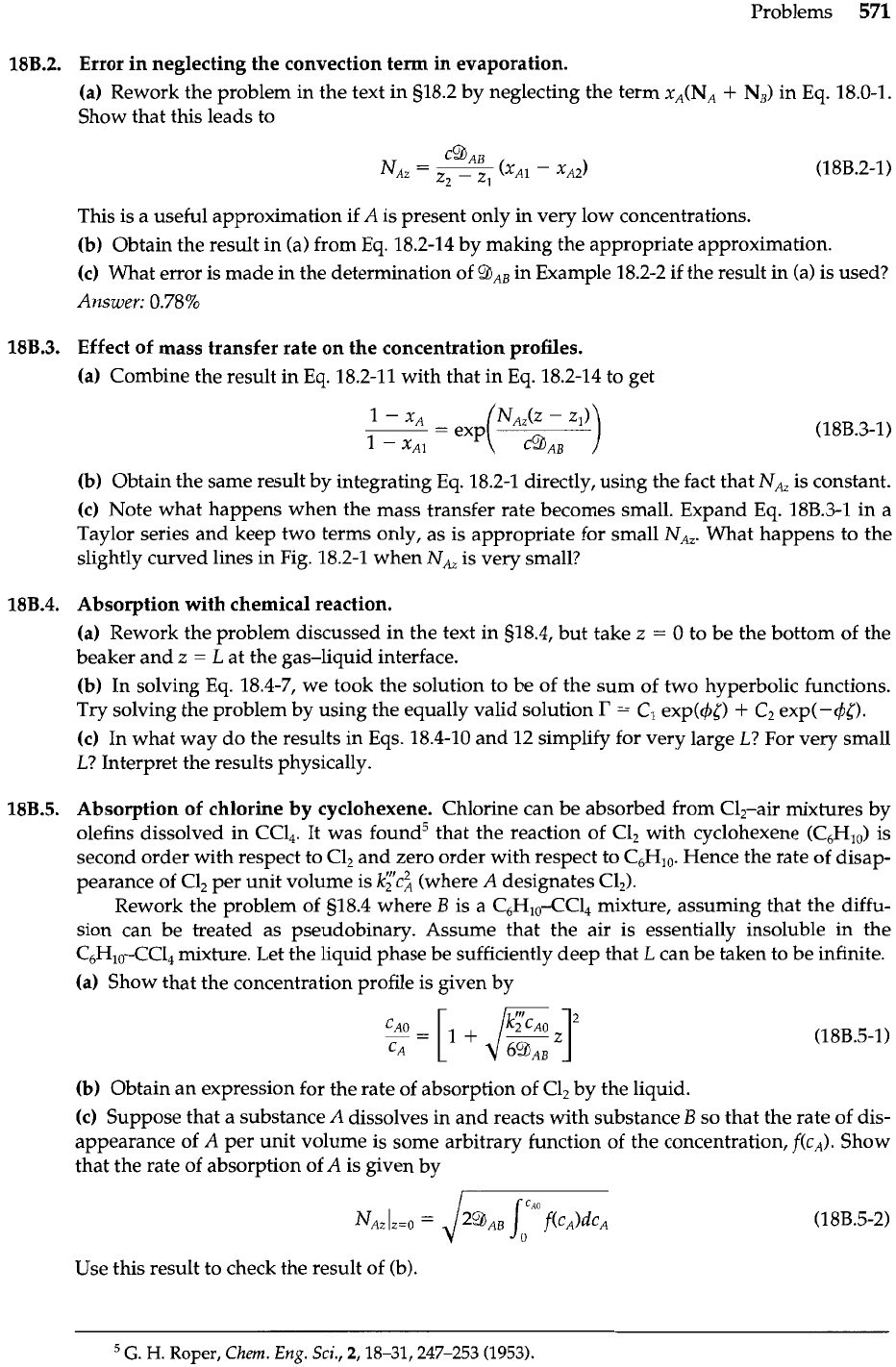
Problems
571
18B.2.
Error in neglecting the convection term in evaporation.
(a)
Rework the problem in the text in s18.2 by neglecting the term xA(NA
+
NJ
in Eq. 18.0-1.
Show that this leads to
This is a useful approximation if
A
is present only in very low concentrations.
(b) Obtain the result in (a) from Eq. 18.2-14 by making the appropriate approximation.
(c)
What error is made in the determination of
9,,
in
Example 18.2-2 if the result in (a) is used?
Answer:
0.78%
18B.3.
Effect of mass transfer rate on the concentration profiles.
(a) Combine the result in Eq. 18.2-11 with that in Eq. 18.2-14 to get
(b) Obtain the same result by integrating Eq. 18.2-1 directly, using the fact that NA, is constant.
(c)
Note what happens when the mass transfer rate becomes small. Expand Eq. 18B.3-1 in a
Taylor series and keep two terms only, as is appropriate for small
Nh.
What happens to the
slightly curved lines in Fig. 18.2-1 when
NA,
is very small?
18B.4.
Absorption with chemical reaction.
(a) Rework the problem discussed in the text in s18.4, but take
z
=
0
to be the bottom of the
beaker and
z
=
L
at the gas-liquid interface.
(b) In solving Eq. 18.4-7, we took the solution to be of the sum of two hyperbolic functions.
Try solving the problem by using the equally valid solution
I?
=
C,
exp(c$t)
+
C2 exp(-&I.
(c) In what way do the results in Eqs. 18.4-10 and 12 simplify for very large
L?
For very small
L?
Interpret the results physically.
18B.5.
Absorption of chlorine by cyclohexene. Chlorine can be absorbed from C1,-air mixtures by
olefins dissolved in CCl,. It was found5 that the reaction of C1, with cyclohexene (C6HI0) is
second order with respect to Cl, and zero order with respect to C,H1,. Hence the rate of disap-
pearance of C1, per unit volume is
k;"ci
(where
A
designates C12).
Rework the problem of 518.4 where
B
is a C,Hl0-CC1, mixture, assuming that the diffu-
sion can be treated as pseudobinary. Assume that the air is essentially insoluble in the
C,Hl0-CC1, mixture. Let the liquid phase be sufficiently deep that
L
can be taken to be infinite.
(a) Show that the concentration profile is given by
(b) Obtain an expression for the rate of absorption of C1, by the liquid.
(c)
Suppose that a substance
A
dissolves in and reacts with substance
B
so that the rate of dis-
appearance of
A
per unit volume is some arbitrary function of the concentration, f(cA). Show
that the rate of absorption of
A
is given by
Use this result to check the result of (b).
G.
H.
Roper,
Chem.
Eng.
Sci.,
2,18-31,247-253 (1953).
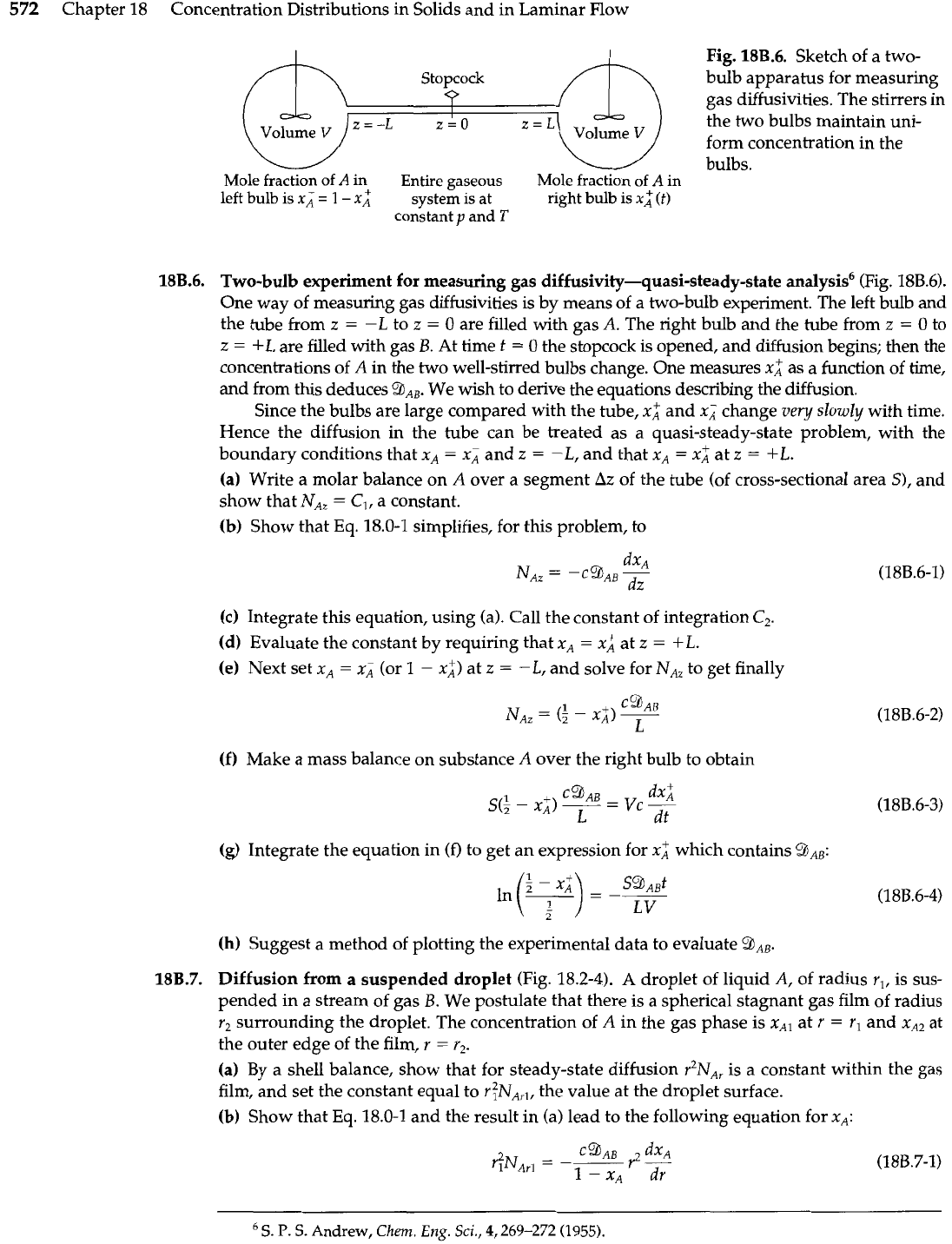
572
Chapter 18
Concentration Distributions in Solids and in Laminar Flow
Fig.
18B.6.
Sketch of a two-
Stopcock
bulb apparatus for measuring
?
gas diffusivities. The stirrers in
z
=
-L
ZLO
z
=
L
Volume
V
the two bulbs maintain uni-
form concentration in the
bulbs.
Mole fraction of
A
in Entire gaseous
Mole fraction of
A
in
left
bulb
is
xi
=
1
-
xi
system is at right bulb is
xi
(t)
constant
p
and
T
18B.6.
Two-bulb experiment for measuring gas
diffusivity-quasi-steady-state
analysis6 (Fig. 18B.6).
One way of measuring gas diffusivities is by means of a two-bulb experiment. The left bulb and
the tube from
z
=
-
L
to
z
=
0 are filled with gas
A.
The right bulb and the tube from
z
=
0
to
z
=
+L
are filled with gas
B.
At time
t
=
0
the stopcock is opened, and diffusion begns; then the
concentrations of
A
in the two well-stirred bulbs change. One measures
xi
as a function of time,
and from this deduces
9,,.
We wish to derive the equations describing the diffusion.
Since the bulbs are large compared with the tube,
xi
and
xi
change
very
slowly
with time.
Hence the diffusion in the tube can be treated as a quasi-steady-state problem, with the
boundary conditions that
x,
=
xi and
z
=
-L,
and that
x,
=
xi
at
z
=
+L.
(a) Write a molar balance on
A
over a segment
Az
of the tube (of cross-sectional area S), and
show that
NAz
=
C,,
a constant.
(b) Show that Eq. 18.0-1 simplifies, for this problem, to
(c)
Integrate this equation, using (a). Call the constant of integration
C2.
(d)
Evaluate the constant
by
requiring that
x,
=
xi
at
z
=
+
L.
(el Next set
XA
=
xi
(or
1
-
xi)
at
z
=
-L,
and solve for Nh to get finally
(f)
Make a mass balance on substance
A
over the right bulb to obtain
(g) Integrate the equation in
(f)
to get an expression for
x,t
which contains
(?&A5:
(h)
Suggest a method of plotting the experimental data to evaluate
9,,.
18B.7.
Diffusion from a suspended droplet (Fig. 18.2-4). A droplet of liquid
A,
of radius r,, is sus-
pended in a stream of gas
B.
We postulate that there is a spherical stagnant gas film of radius
r2
surrounding the droplet. The concentration of
A
in the gas phase is
x,,
at
r
=
r,
and
XA~
at
the outer edge of the film,
r
=
r,.
(a)
By
a shell balance, show that for steady-state diffusion r2NAr is a constant within the gas
film, and set the constant equal to
Y:N~~~,
the value at the droplet surface.
(b) Show that Eq. 18.0-1 and the result in (a) lead to the following equation for
x,:
S.
P.
S.
Andrew,
Chem.
Eng.
Sci.,
4,269-272
(1955).

Problems
573
Fig.
18B.8.
Diffusion of helium through pyrex tubing.
The length of the tubing is
L.
(c)
Integrate this equation between the limits
r,
and
r2
to get
What is the limit of this expression when
r,
-+
m?
.8.
Method for separating helium from natural gas (Fig.
18B.8).
Pyrex glass is almost imperme-
able to all gases but helium. For example, the diffusivity of He through pyrex is about
25
times the diffusivity of
Hz
through pyrex, hydrogen being the closest "competitor" in the dif-
fusion process. This fact suggests that a method for separating helium from natural gas could
be based on the relative diffusion rates through
pyre^.^
Suppose a natural gas mixture is contained in a pyrex tube with dimensions shown in the
figure. Obtain an expression for the rate at which helium will "leak" out of the tube, in terms
the diffusivity of helium through pyrex, the interfacial concentrations of the helium in the
pyrex, and the dimensions of the tube.
A.
%e-~~rex(c~e,l
-
~~e,2)
Answer:
W,,
=
2aL
In
(R2/Rl>
18B.9.
Rate of leachng (Fig.
18B.9).
In studying the rate of leaching of a substance
A
from solid par-
ticles by a solvent
B,
we may postulate that the rate-controlling step is the diffusion of
A
from
the particle surface through a stagnant liquid film thickness
6
out into the main stream. The
molar solubility of
A
in
B
is
c,,,
and the concentration in the main stream is c,,.
(a)
Obtain a differential equation for
cA
as a function of
z
by making a mass balance on
A
over
a thin slab of thickness
Az.
Assume that
9AB
is constant and that
A
is only slightly soluble in
B.
Neglect the curvature of the particle.
Solid
particle
containing
A
Fig.
18B.9.
Leaching of
A
by diffusion into a stagnant
z
=
0
z=6
liquid film of
B.
Scientific American,
199,52
(1958)
describes briefly the method developed
by
K.
B. McAfee of Bell
Telephone Laboratories.
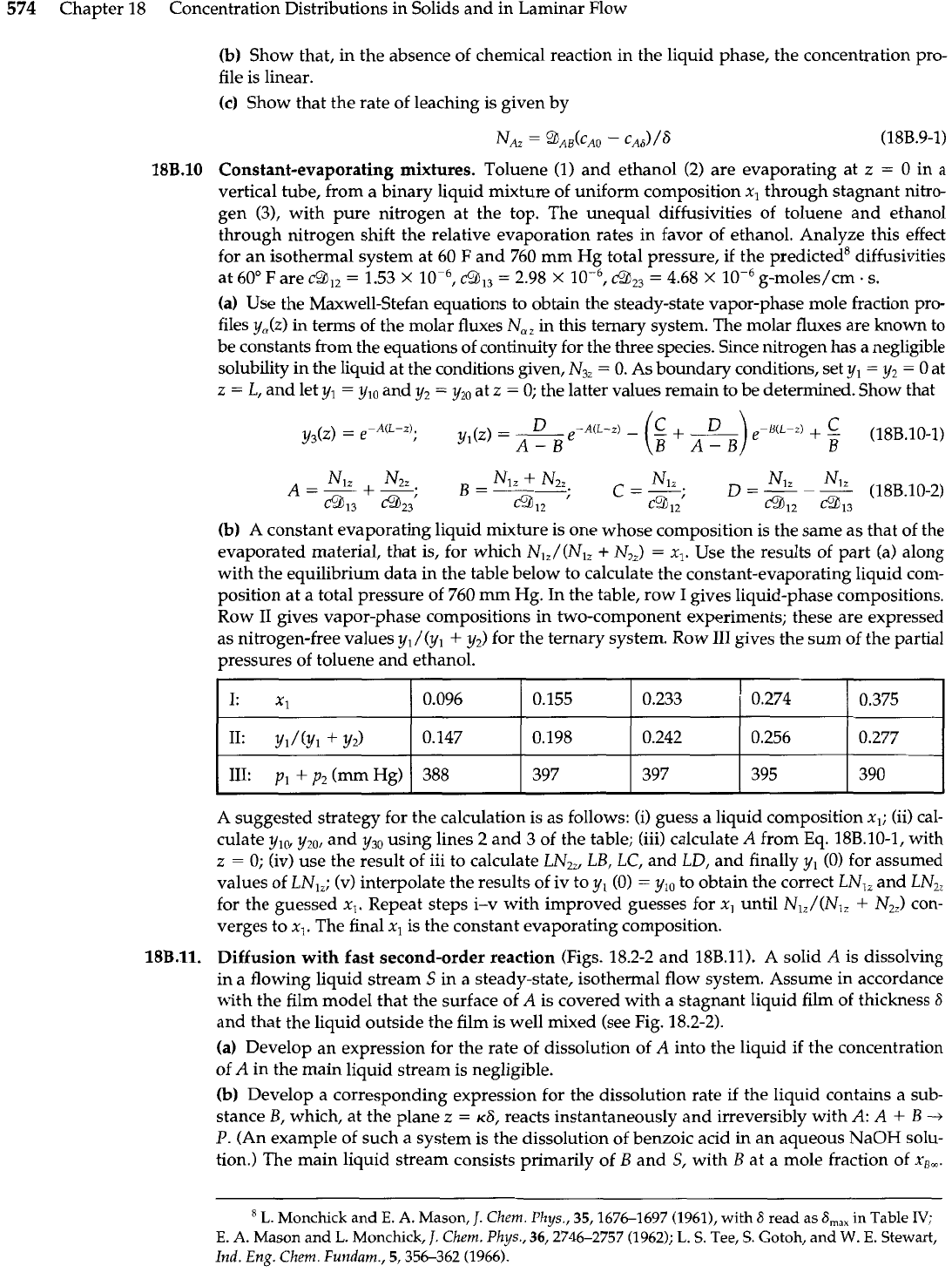
574
Chapter 18 Concentration Distributions in Solids and in Laminar Flow
(b) Show that, in the absence of chemical reaction in the liquid phase, the concentration pro-
file is linear.
(c)
Show that the rate of leaching is given by
18B.10
Constant-evaporating mixtures. Toluene (1) and ethanol (2) are evaporating at
z
=
0 in a
vertical tube, from a binary liquid mixture of uniform composition
x,
through stagnant nitro-
gen (3), with pure nitrogen at the top. The unequal diffusivities of toluene and ethanol
through nitrogen shift the relative evaporation rates in favor of ethanol. Analyze this effect
for an isothermal system at 60
F
and 760 mm Hg total pressure, if the predicted8 diffusivities
at
60"
F are cg12
=
1.53
X
BI3
=
2.98
X
cg2,
=
4.68
X
g-moles/cm s.
(a) Use the Maxwell-Stefan equations to obtain the steady-state vapor-phase mole fraction pro-
files y,(z) in terms of the molar fluxes No, in this ternary system. The molar fluxes are known to
be constants from the equations of continuity for the three species. Since nitrogen has a negligible
solubility in the liquid at the conditions given, N,,
=
0. As boundary conditions, set y1
=
y2
=
0 at
z
=
L,
and let y,
=
ylo and y2
=
y2, at
z
=
0;
the latter values remain to be determined. Show that
A
suggested strategy for the calculation is as follows: (i) guess a liquid composition x,; (ii) cal-
culate
ylof
y2,, and y3, using lines 2 and
3
of the table; (iii) calculate A from Eq. 18B.10-l, with
z
=
0; (iv) use the result of iii to calculate LN2,,
LB,
LC, and LD, and finally yl (0) for assumed
values of LN,,; (v) interpolate the results of iv toy, (0)
=
y,, to obtain the correct LN,, and
LN,,
for the guessed x,. Repeat steps i-v with improved guesses for
x,
until N,,/(N,,
+
N,,) con-
verges to x,. The final
x,
is the constant evaporating composition.
(b)
A
constant evaporating liquid mixture is one whose composition is the same as that of the
evaporated material, that is, for which N,,/(N1,
+
N,)
=
x,.
Use the results of part (a) along
with the equilibrium data in the table below to calculate the constant-evaporating liquid com-
position at a total pressure of 760 mm Hg. In the table, row I gives liquid-phase compositions.
Row I1 gives vapor-phase compositions in two-component experiments; these are expressed
as nitrogen-free values yl/(y,
+
y2) for the ternary system. Row I11 gives the sum of the partial
pressures of toluene and ethanol.
18B.11.
Diffusion with fast second-order reaction (Figs. 18.2-2 and 18B.11). A solid
A
is dissolving
in a flowing liquid stream
S
in a steady-state, isothermal flow system. Assume in accordance
with the film model that the surface of
A
is covered with a stagnant liquid film of thickness
6
and that the liquid outside the film is well mixed (see Fig. 18.2-2).
(a) Develop an expression for the rate of dissolution of A into the liquid if the concentration
of
A
in the main liquid stream is negligible.
(b)
Develop a corresponding expression for the dissolution rate
if
the liquid contains a sub-
stance B, which, at the plane z
=
~6, reacts instantaneously and irreversibly with A:
A
+
B
+
P.
(An example of such a system is the dissolution of benzoic acid
in
an aqueous NaOH solu-
tion.) The main liquid stream consists primarily of
B
and
Sf
with
B
at a mole fraction of x,,.
L.
Monchick
and
E.
A.
Mason,
J.
Chem.
Phys.,
35,1676-1697 (1961), with
S
read as
a,,,
in
Table
IV;
E.
A.
Mason
and
L.
Monchick,
J.
Chern.
Phys.,
36,2746-2757 (1962);
L.
S.
Tee,
S.
Gotoh,
and
W.
E.
Stewart,
Ind.
Eng.
Chern.
Fundarn.,
5,356-362 (1966).
0.375
0.277
390
I:
x1
11: yl
/(yl
+ ~2)
111:
pl
+
p2 (mm Hg)
0.096
0.147
388
0.155
0.198
397
0.233
0.242
397
0.274
0.256
395
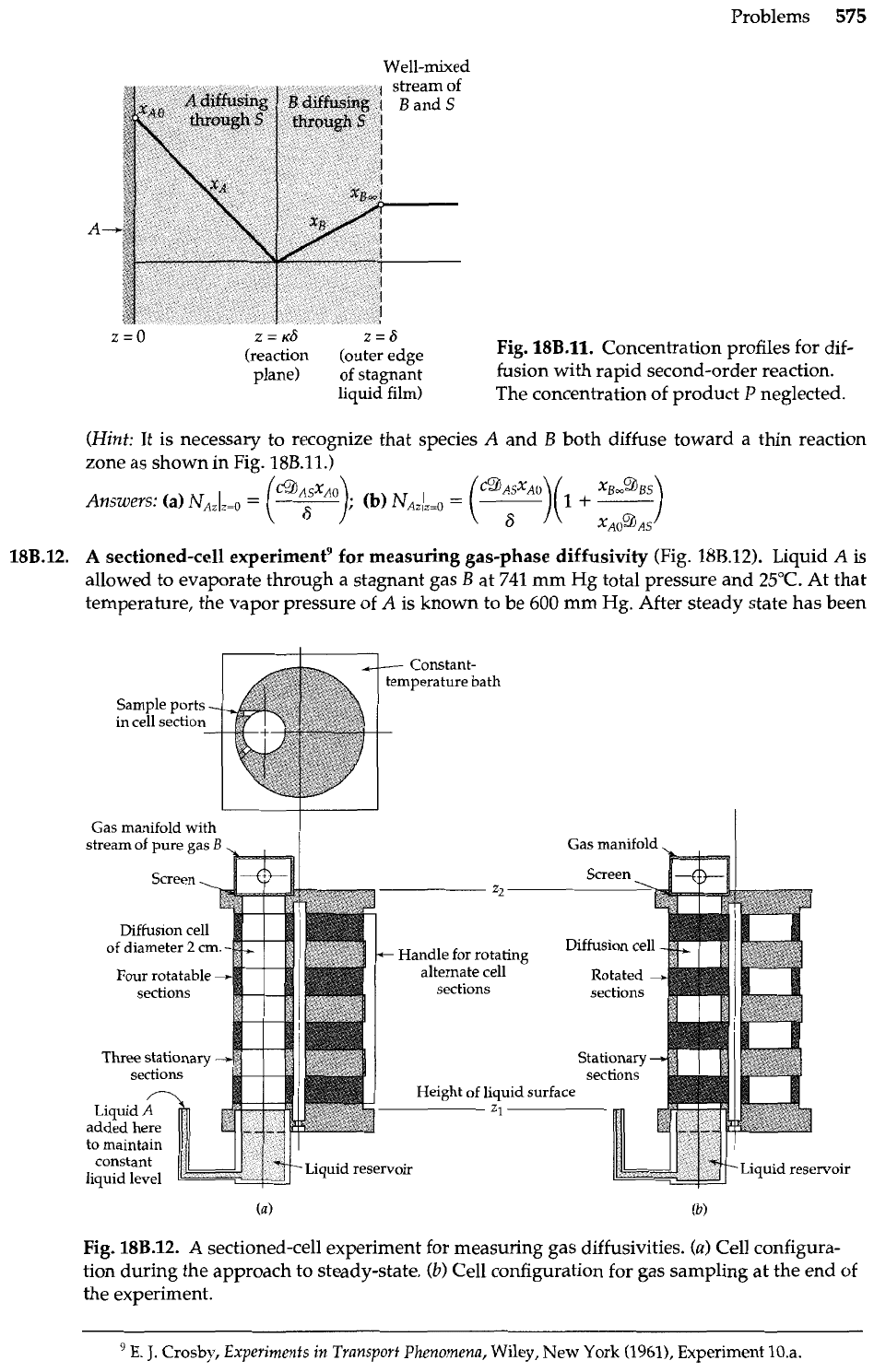
Problems
575
z
=
0
z
=
KS z=S
(reaction (outer edge
Fig.
18B.11.
Concentration profiles for dif-
plane) of stagnant
fusion with rapid second-order reaction.
liquid film)
The concentration of product
P
neglected.
(Hint:
It is necessary to recognize that species
A
and
B
both diffuse toward a thin reaction
zone as shown in Fig. 18B.11.)
18B.12.
A
sectioned-cell experimentg for measuring gas-phase diffusivity (Fig. 18B.12). Liquid
A
is
allowed to evaporate through a stagnant gas
B
at 741 mm Hg total pressure and 25°C. At that
temperature, the vapor pressure of
A
is known to be
600
mm Hg. After steady state has been
Sample ports
-
in
cell section
-
Gas manifold with
stream of pure gas
B
Gas manifold
'bx4w-
Liquid
reservoir
Fig.
18B.12.
A
sectioned-cell experiment for measuring gas diffusivities.
(a)
Cell configura-
tion during the approach to steady-state.
(b)
Cell configuration for gas sampling at the end of
the experiment.
E.
J.
Crosby,
Experiments
in
Transport
Phenomena,
Wiley,
New York
(1961),
Experiment 10.a.

576
Chapter 18 Concentration Distributions in Solids and in Laminar Flow
attained, the cylindrical column of gas is divided into sections as shown. For a 4-section appa-
ratus with total height
4.22
cm, the analysis of the gas samples thus obtained gives the follow-
ing results:
(z
-
2,)
in cm
Bottom Top of Mole
Section of section section fraction of
A
The measured evaporation rate of
A
at steady state is 0.0274 g-moles/hr. Ideal gas behavior
may be assumed.
(a)
Verify the following expression for the concentration profile at steady state:
(b)
Plot the mole fraction
xB
in each cell versus the value of
z
at the midplane of the cell on
semilogarithmic graph paper. Is a straight line obtained? What are the intercepts at
z,
and
z,?
Interpret these results.
(c)
Use the concentration profile of
Eq.
18B.12-1 to find analytical expressions for the average
concentrations in each section of the tube.
(d)
Find the best value of
9JA,
from this experiment.
Answer:
(d)
0.155 cm2/s
18B.13.
Tarnishing of metal surfaces.
In the oxidation of most metals (excluding the alkali and aIka-
line-earth metals) the volume of oxide produced is greater than that of the metal consumed.
This oxide thus tends to form a compact film, effectively insulating the oxygen and metal
from each other. For the derivations that follow, it may be assumed that
(a)
For oxidation to proceed, oxygen must diffuse through the oxide film and that this diffu-
sion follows Fick's law.
(b)
The free surface of the oxide film is saturated with oxygen from the surrounding air.
(c)
Once the film of oxide has become reasonably thick, the oxidation becomes diffusion con-
trolled; that is, the dissolved oxygen concentration is essentially zero at the oxide-metal surface.
(dl
The rate of change of dissolved oxygen content of the film is small compared to the rate
of
reaction. That is, quasi-steady-state conditions may be assumed.
(e)
The reaction involved is
~XO,
+
M
+
MO,.
We wish to develop an expression for rate of tarnishing in terms of oxygen diffusivity
through the oxide film, the densities of the metal and its oxide, and the stoichiometry of the
reaction. Let
c,
be the solubility of oxygen in the film,
cf
the molar density of the film, and
zf
the thickness of the film. Show that the film thickness is
This result, the so-called "quadratic law," gives a satisfactory empirical correlation for a num-
ber of oxidation and other tarnishing reactions.1° Most such reactions are, however, much
more complex than the mechanism given above.''
lo
G.
Tammann,
Z.
anorg. allgem. Chemie,
124,2535
(1922).
"
W.
Jost, Diffusion,
Academic Press,
New York
(1952),
Chapter
IX.
For
a
discussion of the oxidation
of
silicon, see
R.
Ghez,
A
Primer of Diffusion Problems,
Wiley, New York (1988),
52.3.
